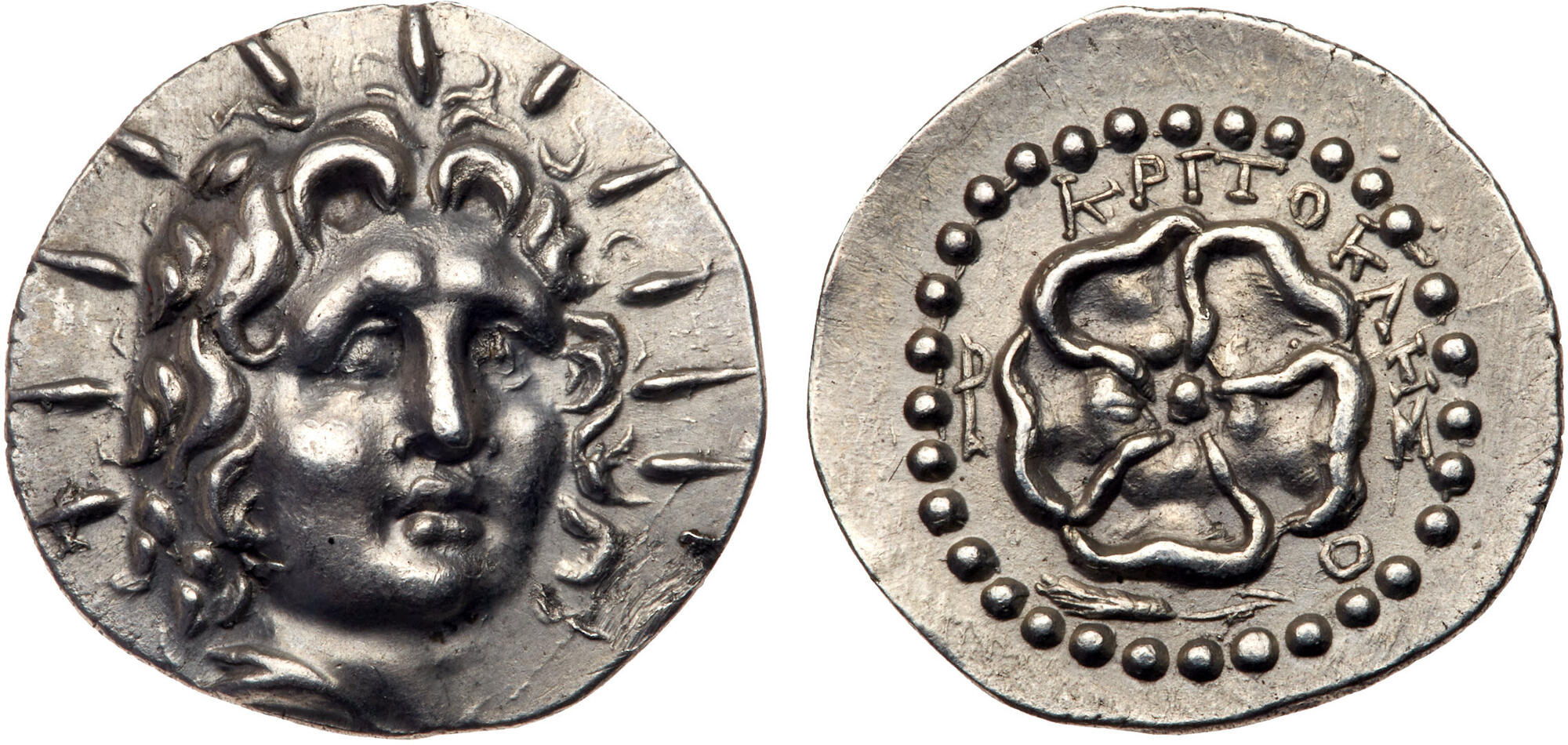Rhodes, silver, drachms (facing Helios/rose) (84-43 BCE)
From SILVER
84 BCE - 43 BCE Silver 11,833 kg
Description
| ObverseInscription or printing placed on the obverse.: | Radiate head of Helios facing slightly right |
| ReverseInscription or printing placed on the reverse.: | P-O - KPITOKΛHΣ (Greek).Rose seen from above, below to left, grain ear |
Mint and issuing power
| MintIdentifies the place of manufacture or issue of a numismatic object.: | Rhodes | Ancient regionAncient region.: | Caria (islands) | Modern countryModern country: Greece | AuthorityIdentifies the issuing power. The authority can be "pretended" when the name or the portrait of X is on the coin but he/she was not the issuing power. It can also be "uncertain" when there is no mention of X on the coin but he/she was the issuing power according to the historical sources: | Rhodian power |
Chronology
| FromIdentifies the initial date in a range assigned in a numismatic context. | 84 BCE | toIdentifies the final date in a range assigned in a numismatic context.. | 43 BCE | PeriodTime period of the numismatic object.: Hellenistic 323-30 BC |
Physical description
| MetalThe physical material (usually metal) from which an object is made.: | Silver |
Median weightMedian of the weights of numismatic objects (in grams). in grams | 4.10 | DenominationTerm indicating the value of a numismatic object. Examples: tetradrachm, chalkous, denarius.: | drachma |
StandardStandard.: |
Image

S982 Rhodes drachms.jpg [1]
References
| Die study referencePublication of the study: | Ashton - Weiss 19971Ashton - Weiss 1997 | ||
| Coin series referenceReference to coin series study: | Sear II2Sear II, n° 5067-5069, HGC 63HGC 6, n° 1456 | ||
| Coin series web referenceCoin series web references: | |||
Obverse dies distribution
| FrequencyFrequency of specimen in distribution. ᵖ | Number of obversesNumber of obverse dies. ᵖ (o) | % (o) | Number of coinsNumber of coins. (n) | % (n) | Die nameName(s) of the die(s). |
| 1 | 40 | 33.33 | 40 | 9.39 | |
| 2 | 25 | 20.83 | 50 | 11.74 | |
| 3 | 9 | 7.5 | 27 | 6.34 | |
| 4 | 14 | 11.67 | 56 | 13.15 | |
| 5 | 10 | 8.33 | 50 | 11.74 | |
| 6 | 7 | 5.83 | 42 | 9.86 | |
| 7 | 6 | 5 | 42 | 9.86 | |
| 8 | 2 | 1.67 | 16 | 3.76 | |
| 9 | 1 | 0.83 | 9 | 2.11 | |
| 11 | 2 | 1.67 | 22 | 5.16 | |
| 15 | 1 | 0.83 | 15 | 3.52 | |
| 17 | 1 | 0.83 | 17 | 3.99 | |
| 18 | 1 | 0.83 | 18 | 4.23 | |
| 22 | 1 | 0.83 | 22 | 5.16 | |
| Total | 120 of 120 | 99.98 | 426 of 426 | 100.01 |
Reverse dies distribution
no distribution is available
Quantification
| Number of obversesNumber of obverse dies. ᵖ (o) | 120 | Number of singletons (o1)The number of singleton coins. ᵖ | 40 |
| Number of reverse diesNumber of reverse dies. (r) | 343 | Number of coinsNumber of coins. (n) | 426 |
| Coins per obverse dieNumber of coins per obverse die. (n/o) | 3.55 | Coins per reverse dieNumber of coins per reverse die. (n/r) | 1.24 |
| Reverse per obverse ratioRatio of obverse dies divided by reverse dies. (r/o) | 2.86 | Percentage of singletons (o1)number of coins (n) divided by the number of singletons (o1) ᵖ | 33.33 % |
| Original number of dies (O) (Carter 1983 formula)The estimation of the number of coins according to Carter 1983 ᵖ | 144.31 | Coins struck if 20,000 as average productivity per dieCoins made if the average productivity for obverses (according to Carter) is 20,000. ᵖ | 2,886,200 |
| Original number of dies (O) (Esty 2011 formula)The estimation of the number of coins according to the singleton formula in Esty 2011 ᵖ (O) | 167.06 | Survival rate if 20,000 as average productivity per dieSurvival rate if average productivity is 20,000. ᵖ | 0.00015 |
| Coverage (o = % of O) (Esty 1984 formula)Esty 1984 - coverage (% of O) ᵖ (o = % of O) | 90.61% | Die productivity if survival rate 1/2,000Average productivity if survival rate is 1/2,000. ᵖ | 5,903.96 |
| Weight of silver (in kg) if 20,000 coins per die (O = Carter formula)Carter 1983 * Median weight * 20000 (*10 if gold or electrum) ᵖ | 11,833 kg <br /> 11,833 kg | Die productivity if survival rate 1/5,000Average productivity if survival rate is 1/5,000. ᵖ | 14,759.89 |
Remarks
References
- ^ Ashton, Richard - Weiss, Arnold-Peter (1997), "The Post-Plinthophoric Silver Drachms of Rhodes", Numismatic Chronicle, 157, p. 1-39, pl. 1-16.
- ^ Sear, David R. (1979), Greek coins and their values. Vol. II, Asia and North Africa, London, xlviii, p. 317-762
- ^ Hoover, Oliver D. (2010), The Handbook of Greek Coinage Series, volume 6 : handbook of coins of the islands: Adriatic, Iionian, Thracian, Aegean, and Carpathian seas (excluding Crete and Cyprus), sixth to first centuries BC, Lancaster, 358 p.